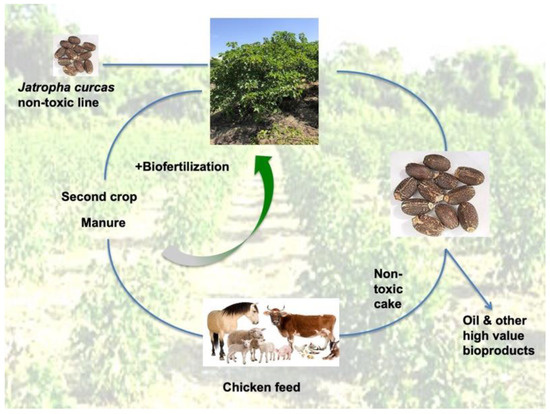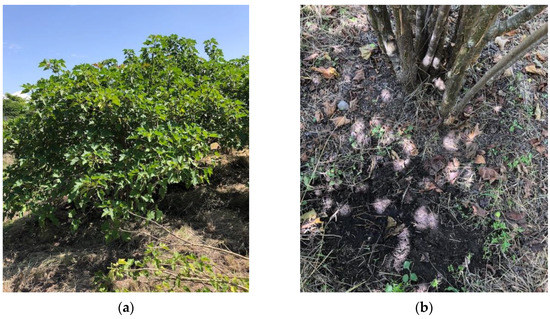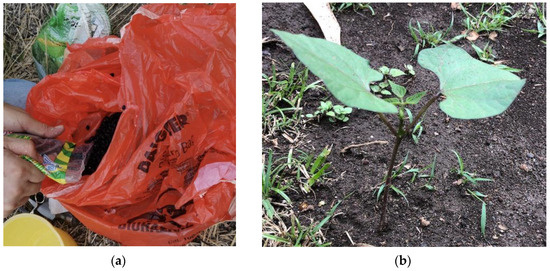Abstract
Jatropha curcas (physic nut) is a promising crop in tropical countries because its seeds have a high oil content that can be easily transformed into biodiesel. The oil can also serve to obtain other bioproducts. However, several obstacles hinder the extensive application of the crop, for example, the relative low prices of petroleum and oil, the toxicity of the seeds, low crop yields and rusticity of the plant. We propose a model in which several biotechnological strategies are applied to increase the crop value of Jatropha, while maintaining the fertility characteristics of the soil, and reducing its carbon and water footprints.
1. Introduction
Jatropha curcas L. (physic nut) is an emergent crop with potential utilization for biofuel synthesis. Specifically, its oil can be easily converted into biodiesel through transesterification. Glycerin is a secondary product of the process [1]. Several characteristics make this plant a future ally in the world’s decarbonization efforts. The plant develops well in dry places, with poor soils, and has good resistance to pests [2]. Despite that, some concerns have arisen regarding the ecological costs of soil conversion for the Jatropha crop [3]. Currently, more than 1 million hectares of Jatropha are planted around the world. A study found that 40% of the utilized surface was previously cleared from vegetation resulting of logging, not related to Jatropha, 34% was defined as unused and the remainder areas were from animal husbandry or other crops [3]. In Mexico, a recognized center of origin of the plant, the agricultural surface occupied by Jatropha is very small [4]. The high and medium yield crop potentials in the states of Gulf of Mexico and those in the Pacific coasts are well known. The best altitudes for the crop are at sea level, with a limit at 1000 m [5].
The toxicity of the plant and seeds are factors preventing a wider use. The presence of phorbol esters in the seeds, as also curcins, is responsible for seed toxicity [6]. After oil extraction, a significant proportion of the biomass (up to 50%), known as seed cake, must be carefully treated and discarded. As a way to achieve a more complete utilization of the seeds, a project in the National University of Mexico developed years ago, led by Dr. Ivonne Toledo, consisted in the search and selection of non-toxic Jatropha lines across the country. Many accessions were tested and some of them were found with undetectable levels of phorbol esters (Toledo et al., unpublished results). A line named Tlaxcala-2, with such a characteristic, was selected to be included in a pilot project. A total of 30 fields scattered in the south of the Morelos state (in central Mexico, 1000 m a.s.l. altitude on average, moderate-to-low rain precipitations) were established in 2015, covering around 30 hectares, with around 20 thousand plants of the Tlaxcala-2 type. The plants are now five years of age. In this project, we propose the application of five biotechnological approaches in order to increase the economic value of the non-toxic Jatropha crop, while maintaining the natural fertility and biodiversity of soils.
2. The Jatropha Farm Model
We propose a circular economy approach for the non-toxic Jatropha crop in order to increase the economic value of the seeds, reuse their residues, conserve the natural fertility of the soils and reduce the ecological impact of the crop. The proposed model is shown in Figure 1.

Figure 1.
Circular economy proposal of the Jatropha Farm.
The non-toxic Jatropha variety was used to establish the parcels. The plants are biofertilized with bacteria and mycorrhizal fungi to increase yield, nutrient solubility and organic matter. Upon harvest, the seeds are transported and used for oil extraction. The oil is useful to convert into biodiesel, but also other bioproducts of high value, such as medicines, cosmetics, paints and specialty oils. The residual cake is used to formulate feed for farm animals, such as pigs, cattle or chickens. Their excreta are returned to the Jatropha plantation to maintain fertility levels. A secondary crop is established in the plantation for maximal use of land surface and additional economic benefits. The remains of secondary crop plants stay in the field to convert into compost for the next season, increasing nutrients and organic matter. The first part of the proposal consists of the Jatropha field experiment; the second part consists of the chicken farm.
3. Preliminary Results
The first part of the Jatropha Farm model was established in Xochitepec, Morelos, Mexico, in a plot property of the KSH Innovación Automotriz, a company with which we have a collaboration agreement. The exact location is 18°43′31.3′′ N, 99°14′46.6′′ W (Figure 2).

Figure 2.
Satellite photograph of the Jatropha Farm model plot (at left). Xochitepec, Morelos, Mexico. Source: Google Maps.
The parcel covers about 1 ha with 800 plants, in 40 rows of 20 plants each, direction North–South. The non-toxic Jatropha plants are 5 years old, healthy, of about 2.5 m height. In the West limit of the parcel, the soil changes visibly to being sandier and the plants are smaller, possibly due to reduced nutrients (Figure 3a). The plots contain 10 plants each. In this part of the field, five treatments with two random-generated repetitions were applied (10 plots). The treatments were as follows:

Figure 3.
(a) Jatropha plant in the model parcel; (b) Application of biofertilizers and manure.
- T1: Control—untreated plots;
- T2: Biofertilized plots. Five grams of Biofabrica Siglo XXI (Cuautla, Morelos, Mexico) combo product, containing Azospirillum brasilense and Rhizophagus irregularis, were applied at a 0.5 m distance from each plant stem (Figure 3b). Chicken manure was also applied (100 g per plant). The cost of this treatment was USD 0.34 per plant (USD 3.40 per plot);
- T3: Secondary crop. Common bean (Phaseolus vulgaris), variety Negro Queretaro, was sown in 2 rows between Jatropha plants, 2 plants per hole, 20 plants per row, 80 plants per plot. The seeds were inoculated with specific nitrogen-fixing rhizobial symbiont, Rhizobium phaseoli CIAT652 strain, prepared in the laboratory (Figure 4a; emerged bean plants, Figure 4b). The cost of this treatment was USD 0.02 per bean plant (USD 1.6 per plot);
 Figure 4. (a) Preparation of common bean seed inoculant; (b) emerged bean plants.
Figure 4. (a) Preparation of common bean seed inoculant; (b) emerged bean plants. - T4: Biofertilized plots plus secondary crop. The combined assay of the two previous treatments. The cost was USD 0.34 per Jatropha plant plus USD 0.02 per bean plant. The cost by plot was USD 5.0;
- T5: Fertilized plants. Chemical fertilizer was bought (formula 18-46-00) and applied at the lower recommended rate of 50 Kg N/ha. The doses were applied as halves, one month apart from each other. The cost per Jatropha plant was USD 0.145 (USD 1.45 per plot).
4. Conclusions
The second part of the proposal (the chicken farm) will be performed with the cake from seeds harvested in this season. Thus, the five proposed biotechnological approaches of the Jatropha Farm will be complete: the use of a non-toxic Jatropha line, the application of biofertilizers, establishing secondary crops, recycling the seed cake, and the reuse of chicken manure. At the end of the season (approximately next October), the economic study will consider the costs and benefits of these strategies. The effect on the soil will be studied, assessing bacterial populations and the content of organic matter. The ecological effect of the mentioned strategies will be studied through carbon and water footprints. The entire experiment will run for two additional seasons, finishing in 2023. Meanwhile, the proposal and the preliminary results will be divulgated in specialized fora, and also in workshops with the general public and the farmers of the Morelos state, who own non-toxic Jatropha parcels. Additionally, we are exploring the conversion of Jatropha oil into high value bioproducts, such as dermatological creams and dielectric oils. We are in the process of obtaining the genome sequence of the non-toxic Jatropha curcas line; it will allow finding differences in comparison with the genomes of toxic Jatropha varieties.
The fundamentals of the project allow for it to be extended to other places and crops. We are collaborating with Jatropha researchers in Ecuador, who are interested in the applications of the model, and also with oil palm producers in Colombia. Additionally, we will research the possible rebound effects on promoting this crop instead of others that are traditionally produced, acknowledging a life cycle approach and a decarbonization scenario relying on electric vehicles in medium to long term, such that claims on the circular economy can be made from a resource perspective.
Author Contributions
Conceptualization, H.P.; methodology, H.P., D.I.A.-O. and J.C.G.-F.; formal analysis, H.P., D.I.A.-O. and J.C.G.-F.; writing—original draft preparation, H.P.; writing—review and editing, H.P., D.I.A.-O. and J.C.G.-F.; visualization, H.P.; funding acquisition, H.P., D.I.A.-O. and J.C.G.-F. All authors have read and agreed to the published version of the manuscript.
Funding
This research was funded by the Director Office, Center for Genomic Sciences-UNAM, Mexico.
Institutional Review Board Statement
Not applicable.
Informed Consent Statement
Not applicable.
Data Availability Statement
Not applicable.
Acknowledgments
We gratefully acknowledge the participation and support of Alejandro Aguilar and Gabriela Guerrero (CCG-UNAM) for work on the Jatropha genome, Eng. Nancy Reyes García and Victor Haddad (KSH Innovación Automotriz, S. A.) in the field experiments, and Stephanie Polette Romero Alvarez and Mauricio Maldonado Rodríguez (University of Morelos) for work on the oil bioproducts. The authors are participants in the ExpertODS group of SDSN-Mexico initiative.
Conflicts of Interest
The authors declare no conflict of interest. The funder had no role in the design of the study; in the collection, analyses, or interpretation of data; in the writing of the manuscript; or in the decision to publish the results.
References
- Foloranmi, J. Production of biodiesel (B100) from Jatropha oil using sodium hydroxide as catalyst. J. Pet. Eng. 2013, 2013, 956479. [Google Scholar] [CrossRef]
- Ratree, S. A preliminary study on physic nut (Jatropha curcas L.) in Thailand. Pak. J. Biol. Sci. 2004, 9, 1620–1623. [Google Scholar]
- Walmsley, D.C.; Bailis, R.; Klein, A.-M. A global synthesis of Jatropha cultivation: Insights into land use change and management practices. Environ. Sci. Technol. 2016, 50, 8993–9002. [Google Scholar] [CrossRef] [PubMed]
- Córdova, L.; Bautista, E.; Zamarripa, A.; Rivera, J.A.; Pérez, A.; Sánchez, O.M.; Martínez, J.; Cuevas, J.A. Diagnóstico y Plan Estratégico de Jatropha spp. en México; Servicio Nacional de Inspección y Certificación de Semillas: Mexico City, Mexico, 2015; 116p. [Google Scholar]
- Rodríguez, M.; Vega, K.; De Gante, V. Distribución del género Jatropha L. (Euphorbiaceae) en el estado de Puebla, México. Polibotánica 2009, 28, 37–48. [Google Scholar]
- Neu, P.M.; Mittelbach, M. Quantification of phorbol esters in Jatropha curcas by HPLC-UV and HPLC-ToF-MS with standard addition method. Eur. J. Lipid Sci. 2018, 120, 1800146. [Google Scholar] [CrossRef] [Green Version]
Publisher’s Note: MDPI stays neutral with regard to jurisdictional claims in published maps and institutional affiliations. |
© 2021 by the authors. Licensee MDPI, Basel, Switzerland. This article is an open access article distributed under the terms and conditions of the Creative Commons Attribution (CC BY) license (https://creativecommons.org/licenses/by/4.0/).